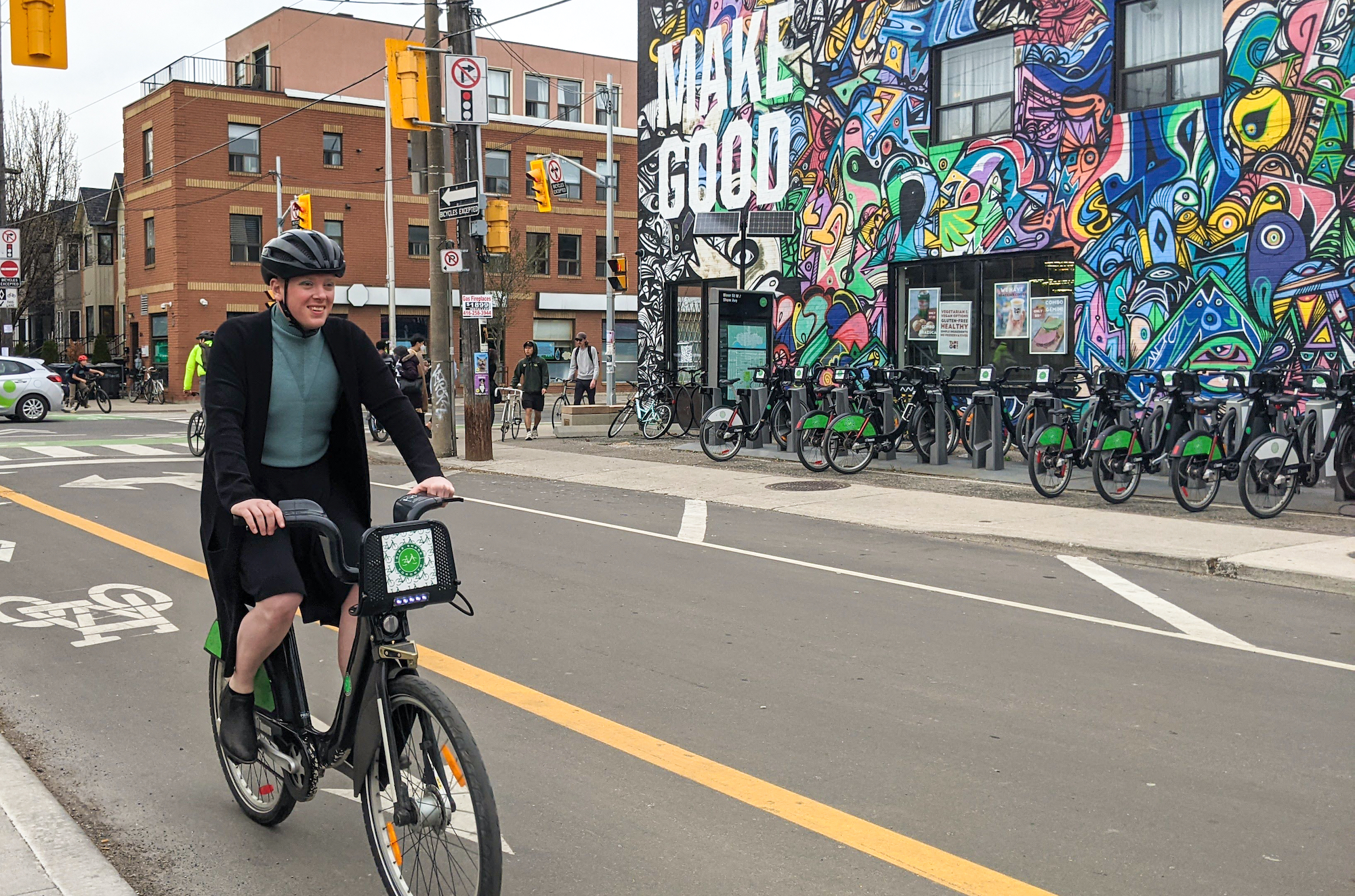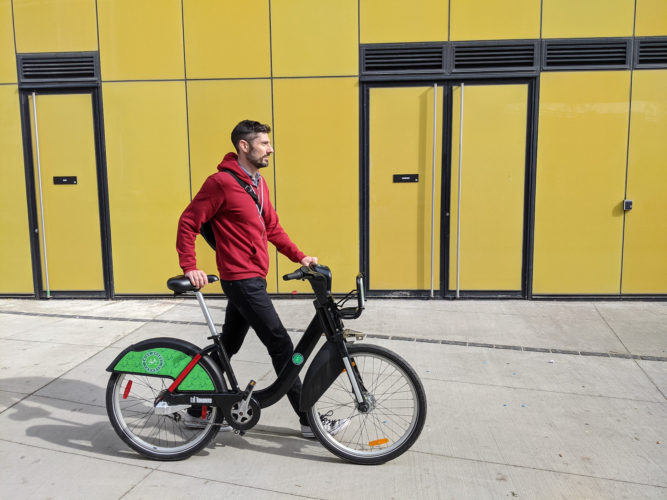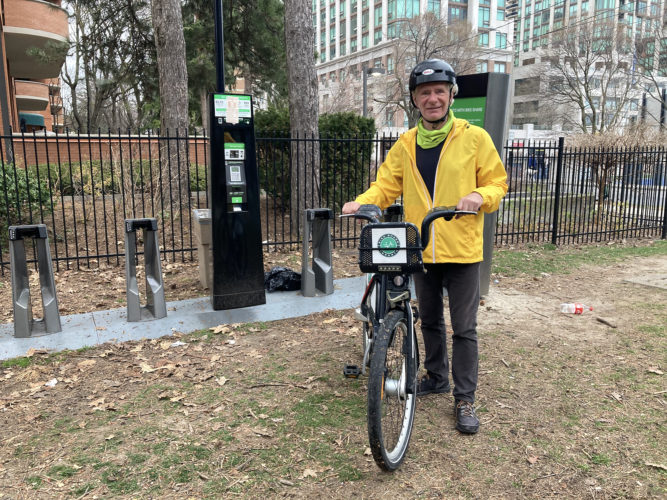COVID in Toronto
Toronto bike sharing trips have surged during COVID-19

caption
Ry Shissler says they’d like to see lessons learned from last year “not just thrown aside as emergency measures.” Chief among them are that people will ride bikes if it’s safe to do so and the infrastructure is there.Torontonians turned to program in record numbers in 2020 as they got outdoors and avoided transit
Editor's Note
These data-driven stories on COVID-19 were prepared by King's MJ students.
When Al Rezoski got a flat tire on his bike at the Leslie Street Spit in Toronto last June, alone and seven kilometres from home, he knew there was only one solution.
“I went to the Toronto Bike Share station at the beginning of the Spit, put my bike on the bike share bike and then transported it back to my house.”
That trip, which Rezoski recalled as a “good workout” because it was a windy day, was one of 2.9 million logged by the Toronto Bike Share Program in 2020. A longtime member—he was one of the first 10 when the program launched as Bixi in 2011—Rezoski had been enjoying a bicycle ride away from crowds while respecting the city’s physical distancing bylaw, just one of the many ways pandemic life looked different.
The city was thick with bikes last year. Finding one to buy was hard. Everyone seemed to be outside. No one wanted to take public transit. Cycling infrastructure exploded. The upshot? Toronto’s bike sharing program had its best year ever.
The Signal analyzed data on more than five million individual trips using Toronto Bike Share, obtained from Toronto’s open data site. The service counted half a million more trips in 2020 than in 2019. There was a modest increase in rides by annual members, while trips by casual users, those buying a single trip, or a one- or three-day pass, almost doubled.
A COVID wind blows
Winter 2020 brought the expected—cold and snow—and the unexpected, a novel coronavirus that caused a disease called COVID-19 and that has killed more than three million people worldwide including more than 23,000 in Canada.
Before the pandemic, winter cycling was for the hardiest of Torontonians, the kind who attract and seem impervious to askance looks tinged with admiration.
“The thought of going for a bike ride in February would have never crossed my mind,” said Stephen-Thomas Maciejowski, an annual bike share member who lives near Allan Gardens in the city’s core. Worried about COVID-19, he took the icy plunge.
“So even through the winter, if I was going over to Riverside to go for a walk with a friend, I would bike there, because I didn’t want to get on public transit. I just learned to, like, layer up.”
In early 2020, the number of bike share trips first rose, then plummeted.
Maciejowski was part of the early winter bump, which coincided with Toronto recording Canada’s first case of the novel coronavirus on Jan. 25, 2020. On March 17, Ontario declared a state of emergency; Toronto followed course on March 23. Trips tumbled, especially for annual members, many of whom took bike share to work.
Cycling for health
Then came May. Torontonians fled isolation for the outdoors. The city launched ActiveTO, urging residents to get fresh air, albeit two metres from non-household members. On Saturday, May 23, trips reached 20,911, a record, according to Bike Share Toronto. From there, nine more days would break records until Sunday, September 6, which crowned them all at 23,554. Trips continued apace to the end of the year.
David Nash estimates he took upwards of 200 bike share rides last year. He said such trips were “super important” for keeping him sane.
“This was the source of almost all of my socializing. With cycling, you have to be six feet apart. Like, how can you not be?”
The program limits trips to 30 minutes. All riders must return their bikes to a docking station within this time, but annual and short-term passholders can take another one out immediately at no charge.
Maciejowksi and a friend took extended rides on Sundays, swapping their bikes as needed.
“We can’t see each other inside, but you know, we go for a walk or a bike ride, and for both of us, it’s kept us sane,” he said. He also cycled to the waterfront with a book, to look at the water, something he hadn’t done before.
“I’m like, OK; this makes me feel better.”

caption
Stephen-Thomas Maciejowski uses bike sharing to avoid taking the TTC, and to stay mentally and physically fit while socializing safely. Sunday bike trips with a friend are a big part of this.A Statistics Canada report from May 2020 found that almost one-quarter of people rated their mental health as fair or poor because of the pandemic. More than one-half said their mental health was worse because of physical distancing.
Fitness motivated many of Rezoski’s 600 bike share spins. If he’s carrying a 10-kilogram bag of kitty litter for a friend or cycling uphill, then that’s a bonus.
“It’s definitely better for your brain and for your body to be exercising outside,” he said.
Maciejowski agrees. Unable to go to his shuttered gym, he has traded weightlifting for cardio-centric cycling.
“It’s better for the soul, I think, because you’re out enjoying the sun.”
Avoiding public transit
Henry Chen gave up his membership in 2019. It didn’t make sense to pay for a year’s use at $99 when he had his own bike. Then the pandemic hit. It still didn’t make sense to get an annual pass, but on the infrequent occasions he needed one, he got a short-term pass. He took about 15 trips using Toronto Bike Share last year, paying $3.25 each time.
He pedalled to visit friends who live downtown, 15 minutes from his midtown place at Yonge and Eglinton, when he wanted to avoid being sardined on public transit or didn’t feel like having to bike back.
“The bike is in open space, where with the TTC, you’d have to be in the same room with a lot of people, so I think it’s safer to ride a bike,” Chen said.
He’s not alone. A TTC-commissioned survey of 2,000 customers March through June 2020 found that more than 50 per cent were riding the TTC less, and 31 per cent not at all. Only 15 per cent said they felt safe on the TTC. The top reason? Fear of crowding.
An infectious new world brought bike hygiene to the fore.
The first time he took a bike out after the pandemic was declared, Nash said he thought, “Oh my God. I’m going to touch those handles. I wonder who else has touched those handles. I started thinking weird things about it, and then I just went ahead and did it.” 
caption
Avid cyclist David Nash uses bike sharing for in-town trips when it’s not convenient to take his own bike and during the winter. He took about 200 such trips last year.
“I’ve made it a protocol to always carry hand sanitizer with me,” said Maciejowski. Once on the bike, he doesn’t answer his phone. If he needs to check his map, which is on his phone, he goes through a sanitizing procedure while perched upright on the seat.
“I probably look ridiculous, and I’m probably going overboard, but it makes me feel more comfortable.”
A cycling infrastructure bonanza
Toronto Parking Authority, which runs the program, added 160 stations and 1,850 bikes last year, bringing its fleet to 6,850 bikes docked at 625 stations. The changes were planned pre-pandemic.
Through ActiveTO, the city added 40 kilometres of bike lanes and closed four major streets to cars on weekends. An evaluation found 29 per cent of people rode a bike for the first time or rediscovered cycling last year, in large part because of the street closures.
The Signal analyzed the bike share data to find the 25 most popular stations to get a bike. The results showed that in 2020 most of the top locations were along the Lakeshore, which was part of ActiveTO. This pattern was different from that seen in 2019. You can swipe back and forth to see the change.
Ry Shissler, a communications manager at the biking charity Cycle Toronto, said this is why new stations should be aligned with street closures.
“We’ve seen those installations as huge drivers of new cyclists,” they said (Toronto Bike Share is a supporter of Cycle Toronto, but does not influence its advocacy, Shissler said).
“So this is the sort of alignment of, if you’re going to build infrastructure, you should also be providing ways to use the infrastructure,” they said.
As they noted, most of the new infrastructure was downtown.
“We found that the buses in the inner suburbs were still really busy. There are lots of outbreaks in warehouses and factories and places where people have continued going to work, but they don’t necessarily have other options besides taking the bus.”
Shissler has an annual bike share pass, as well as their own bike. They count themselves privileged, because they live centrally and have eight stations within a five-minute walk.
Nash lives at Spadina and St. Clair. He has seven docking stations nearby. He’s a fan of e-bikes, which the program introduced last August. He planned to take one to get his COVID-19 vaccine in the city’s west end.
“I looked on the (bike share) map and thought, why isn’t this map showing me where the cycle stations are at Dufferin and Eglinton? Then I looked more closely, and there aren’t any.”
Access to Bike Share Toronto remains unbalanced
Most stations are within the core, which Shissler finds problematic.
“In order to build the culture of cycling, you need to have access, and part of that could be bike sharing. As a public service, that should be serving the people everywhere.
“We would really love to see it expanded equitably,” they said.
Rezoski agrees the availability of cycling infrastructure is uneven, something he’s observed in his work as a city planner.
“We have a lot of suburban areas in Toronto that are physically isolated, and they don’t have Toronto Bike Share. We need to place a greater emphasis on getting Toronto Bike Share in these areas,” he said.
The Signal mapped the locations of Toronto Bike Share stations, showing a concentration in the city centre and few in the inner suburbs, where most of the city’s neighbourhood improvement areas and emerging neighbourhoods are located. These areas are neighbourhoods with greater social and economic needs and are shown in purple (improvement areas) and blue (emerging neighbourhoods) on the map. You can click on the arrows to see the legend and further explanation. The size of the green dots represents the number of stations in that neighbourhood area.
A memorable trip for Rezoski last summer underscored what better access could look like.
While cycling the Hydro Finch Corridor in the city’s northwest with a friend on their own bikes, they came across an arresting sight.
“We saw these younger people on Toronto Bike Share, and we just stopped, and we’re like, ‘Wow; you’re a long way from a Toronto Bike Share station.’ And they said, ‘Oh, no. It’s new. It’s up here. And we’re using it right away. We love it.’”
He had forgotten that stations had been added nearby in a pilot program. They chatted with the teenaged girls.
“They were just kind of like giggling, and you could tell it was like a super, super novelty to them.”
In an email, a spokesperson for Toronto Bike Share said it is launching a study into where to expand in future. She added it would consider the public interest in adding stations in the inner suburbs.
As for the 40 kilometres of new bike lanes, Shissler said they are concerned that more than one-half are temporary. Cycle Toronto is lobbying the city to keep them once the pandemic is declared over.
“What we saw last year is that when people are given the opportunity to go outside and ride in safe spaces, they do. This is what people want,” they said.
About the author

Stephanie Roberts
Stephanie Roberts (@StephRobertsTO) is a Toronto-based freelance writer and Master of Journalism student at the University of King’s College....

T
Tom Hodge
K
Kevin Hamilton
S
Stephen-Thomas Maciejowski